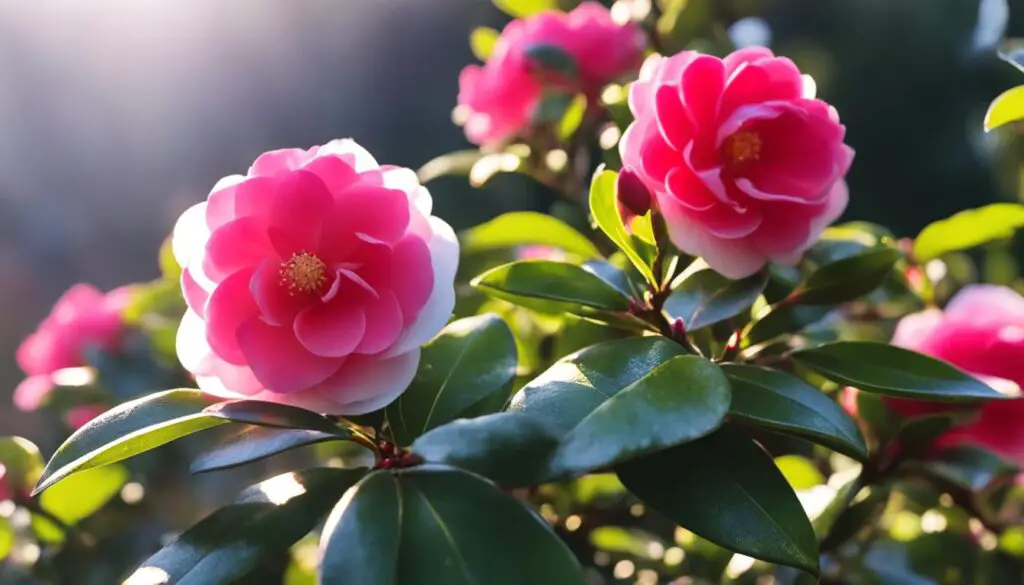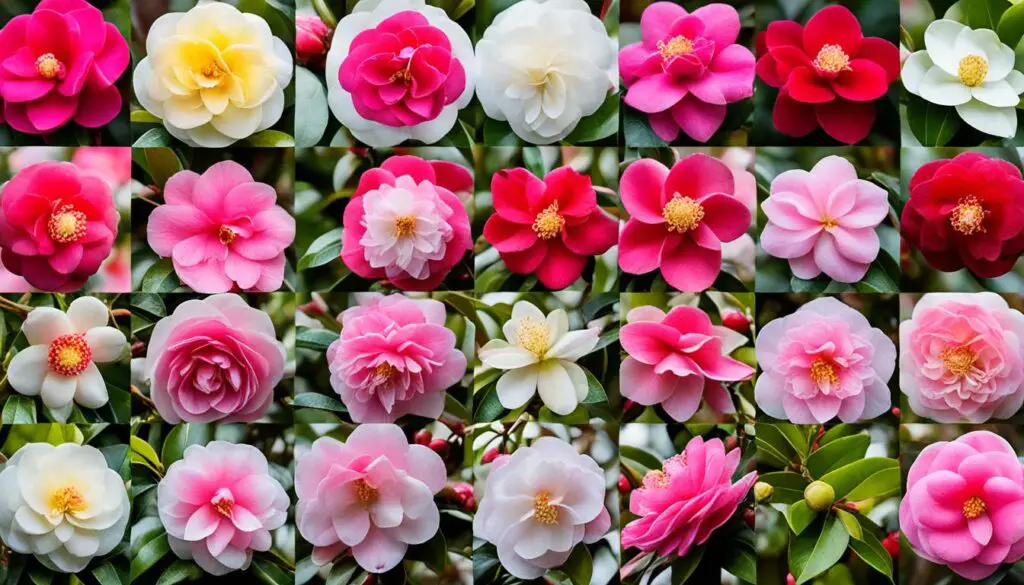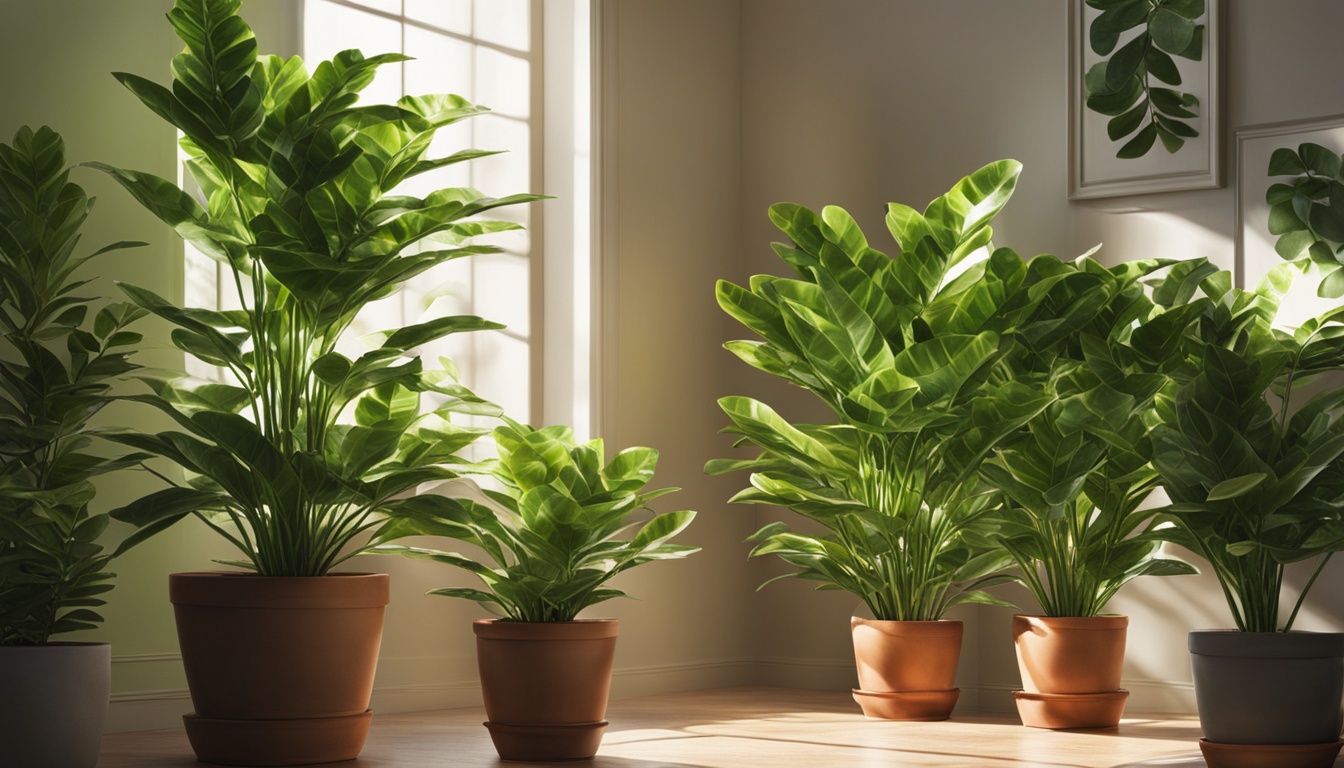Camellias are loved for their vibrant flowers, and the Japanese camellia is a top pick. This shrub is known for its dark, shiny leaves and stunning flower clusters. These flowers come in many colors during winter and early spring, drawing in bees and birds.
However, taking care of this shrub is a bit challenging. It’s very particular about where it grows and can be hit by pests and diseases. If you live below USDA zone 7, you can grow and keep Japanese camellias in pots through the winter.
These plants grow slowly but are great for creating a natural screen. With thousands of types, they vary in bloom time, size, and flower shape. Some can even be trained to grow up walls or fences.
Despite their thick roots, these shrubs don’t spread out much. They’re well-behaved in gardens.

Key Takeaways
- Japanese camellias typically grow to a mature size of 7-12 ft. tall and 5-10 ft. wide.
- The hardiness zones for Japanese camellias range from 7-9 (USDA).
- Japanese camellias bloom in fall, winter, and spring, with flower colors including white, red, pink, and purple.
- Camellias prefer partial shade, slightly acidic soil, and consistent moisture for healthy growth.
- Japanese camellias require specific care during winter, with those in colder regions needing protection from frost.
Planting and Growing Conditions for Japanese Camellia
Choosing the Right Location
Japanese camellias grow best in partial shade, especially in the afternoon. They love the dappled light of a woodland garden. This lets them enjoy the morning sun but stay cool in the hot afternoon.
As they get older, camellias can handle more sunlight. But starting them in a shaded spot is best.
Soil Requirements
Camellias do well in slightly acidic, moist, and well-drained soil. The perfect soil pH is between 5.5 and 6.5. If your soil isn’t right, consider growing them in a container.
Adding organic matter or peat moss can make the soil acidic. But don’t plant too deep or use too much mulch to avoid diseases.
Camellias grow slowly, about 12 inches a year. They like cooler temperatures and are hardy in USDA Zones 6-10.
They need well-drained soil rich in organic matter and should be watered twice a week, up to 1 inch per week.
These acid-loving plants do best with a soil pH near 5.0 to 6.5.
| Camellia Growth Characteristics | Ideal Conditions |
|---|---|
| Growth Rate | 12 inches per year |
| Hardiness Zones | 6-10 |
| Soil pH | 5.0 to 6.5 |
| Soil Moisture | Moist, well-drained |
| Sun Exposure | Partial shade, dappled shade |
| Watering Needs | 1 inch per week |
By giving your Japanese camellia the right conditions and soil, you’ll enjoy its beautiful blooms for many years.
How To Grow A Japanese Camellia and Care
To grow a thriving Japanese camellia, you need to pay close attention to its care. Let’s look at the important parts of japanese camellia watering, japanese camellia fertilizing, and japanese camellia winter protection.
Keeping your Japanese camellia moist is key for lots of blooms. Mulch around the base to keep the soil moist. But, don’t overwater, as it can cause root rot. Aim for soil that’s always moist but not too wet.
Fertilizing is crucial for your camellia’s growth and blooms. Use a high-potassium fertilizer every month in the summer to help with flowers.
In spring, switch to a slow-release, nitrogen-rich fertilizer for green leaves. Don’t fertilize after July to avoid new growth that might not make it through winter.
It’s important to protect your Japanese camellia from big temperature changes. Pick a spot that shields it from cold winter winds. If you live in a really cold area, bring potted camellias inside for the winter.
Keep them in a spot where it doesn’t get above 55 degrees Fahrenheit. This keeps your plant safe from frost and harsh weather.

By keeping up with japanese camellia watering, using the right japanese camellia fertilizing plan, and protecting it from the cold, you can grow a beautiful Japanese camellia. It will give you lovely flowers every year.
Popular Japanese Camellia Varieties
Camellia japonica, or the Japanese camellia, is the most popular and loved camellia species. It has many cultivars, each with its own unique features like bloom time, size, shape, and color. Let’s look at some top Japanese camellia varieties for your garden.
‘Betty Sheffield Supreme’ blooms in midseason with large, white petals and pink-red blotches. ‘Carter’s Sunset’ has big, semi-double pink flowers that last a long time.
‘Korean Fire’ has bright red, funnel-shaped flowers and is more cold-hardy. ‘Kramer’s Surprise’ is fragrant with bright red, peony-form blooms.
There are over 2300 named Japanese camellia varieties, according to the American Camellia Society. Whether you like classic white and pink or bold red, there’s a camellia for every garden.

Japanese camellias are known for their beauty, with different bloom times and sizes. They offer endless options for gardeners and plant lovers. Explore these beautiful flowers and find the perfect one for your garden.
Pruning and Propagating Japanese Camellias
Japanese camellias don’t need a lot of pruning. In fact, too much can harm their natural look. It’s best to remove dead, damaged, or very long shoots after they stop flowering. This keeps the plant healthy and encourages new growth.
For growing more camellias, layering is a great method. It lets a new plant grow roots while still attached to the main plant. Growing them from seed is tricky because the new plants might not look the same as the parent.
Pruning Japanese camellias should be gentle. Layering is a good way to increase your camellia collection. With care, these beautiful evergreens can bring joy for many years.
FAQ
What are the key growing conditions for Japanese camellias?
Japanese camellias thrive in well-drained, slightly acidic soil with a pH of 5.5 to 6.5. They need consistent moisture but not too much. Plant them in a spot with morning sun and dappled afternoon shade. Also, protect them from cold winter winds.
How do I care for my Japanese camellia?
Feed your Japanese camellia with a high-potassium fertilizer every month during summer to boost flowers. In spring, use a slow-release nitrogen fertilizer for healthy foliage. Don’t fertilize after July to avoid winter damage.
In colder areas, bring potted camellias inside during winter. Keep them in a spot where temperatures don’t go above 55 degrees F.
What are some popular Japanese camellia varieties?
Popular varieties include ‘Betty Sheffield Supreme’, a midseason bloomer with large white flowers and red and pink borders. ‘Carter’s Sunset’ has large, semi-double pink flowers that bloom for a long time.
‘Korean Fire’ offers funnel-shaped red flowers that are more cold-hardy. ‘Kramer’s Surprise’ is known for its fragrant, bright red flowers.
How do I prune and propagate Japanese camellias?
Prune Japanese camellias lightly to keep their natural shape. Remove dead or damaged branches right after they flower. This helps with branching and keeps new flower buds safe.
Home gardeners can propagate Camellia japonica through layering. This method allows the new plant to grow roots while still attached to the parent. Growing them from seed is not recommended as it doesn’t ensure a true copy of the parent plant.



